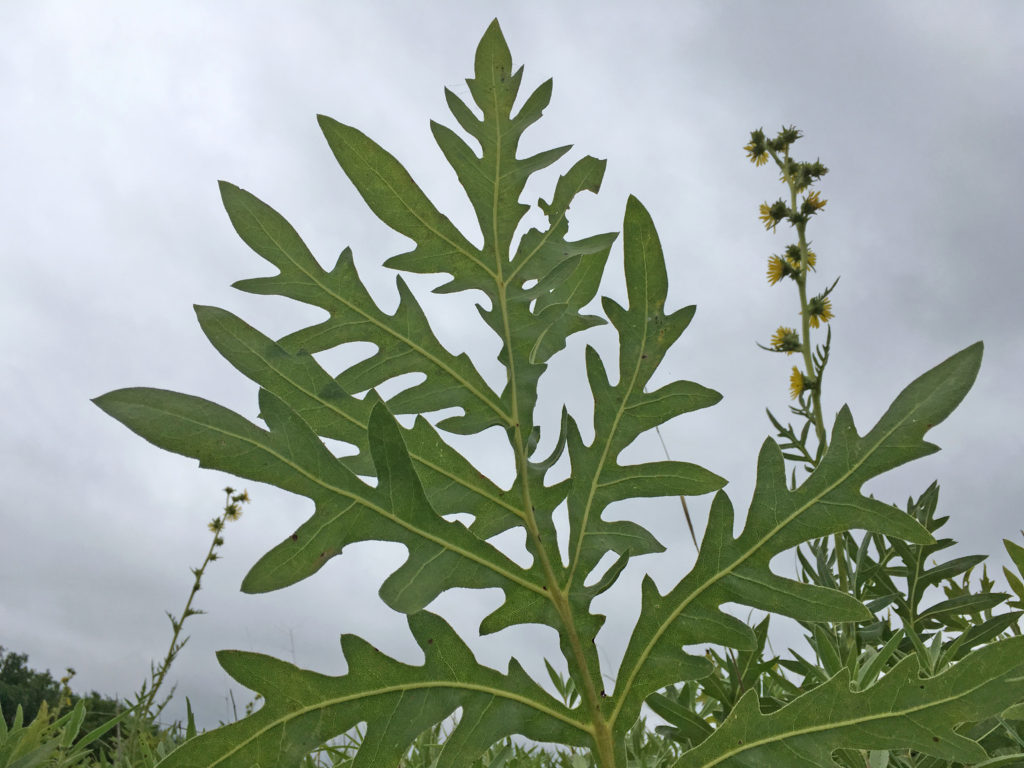Late July to early August is a great time of the year to be celebrating Silphiums. Scott wrote a Silphium post last summer highlighting the four species we can grow well in south central Kansas. I noticed during a recent walk around the Arboretum how brilliantly all four of these species are flowering right now and felt that they were worth recognizing once again. Review Scott’s post at the link above to become familiar with the four species we have in the Arboretum. I’ll touch on a few additional features of this genus in more depth.
Leaf Orientation and Morphology
Compass plant gets its name because the leaves tend to orient north and south and take advantage of cooler morning and evening sunlight to photosynthesize. When the sun is directly overhead during hotter times of the day, compass plant leaves have less direct sun exposure to minimize heat buildup and moisture loss. Cup plant does the same thing. Go HERE for an article in the American Journal of Botany for more on this topic.
Leaf morphology (or shape and form) plays its part too. Deeply lobed compass plant leaves have greater surface area than cup plant, which may translate to a more efficient heat radiating capacity (think of the function of a car radiator with all its coils and fins to maximize cooling potential).
Of the four species that Scott highlights, cup plant is the only Silphium species that doesn’t have a native range in Kansas (even though it seems to grow well here). Its range is east and north of Kansas where average precipitation levels are higher and temperatures are lower. Compass plant extends into drier and warmer climates and so this difference in leaf morphology between the two species may be a plausible adaptation for dealing with climate variation. Dense white hairs on Silphium leaves also help reflect sunlight and reduce wind speeds at the leaf surface. Both can reduce moisture loss.
Comparison to Sunflowers
Even though Silphiums are in the sunflower family (Asteraceae), they differ physiologically in their seed formation. You probably know that typical sunflower family flowering heads have both disc and ray florets. The ray florets act as sterile pollinator attractors and the disc florets are the seed producers. Our state flower, annual sunflower (Helianthus annuus), is one good example. Silphiums are just the opposite in that the attractive ray florets are the seed producers. Botany geeks are fascinated by these kinds of things, but I’m sure the more casual observer will find this equally as riveting.
Easy to Grow
When it comes to growing native plants in your landscape, few are easier to establish than Silphiums. That’s the positive way to look at it. If you ask anybody who has had experience growing Silphiums as an ornamental in their manicured landscape, they will probably cite that they are invasive and problematic. Some use more pointed, even colorful language. You won’t notice this for the first few years while they are establishing. But when they start flowering in year four or five and seeds start dropping, that is when the invasion begins. Because each Silphium plant grows to a sizeable diameter of three feet or more, and the plants grow to a substantial height, they can become downright bullies.
So, we still encourage people to enjoy Silphiums for all the apparent reasons…colorful flowers during the heat of the summer, interesting foliage, and a great attractor of all sorts of insects via flowers and vegetation. But plant them in an area such as a prairie restoration or a less ornamental landscaped area where you won’t be as concerned with its aggressiveness or be judicious with deadheading. Keep scale in mind too with regard to the 6-9 feet height of Silphiums and the size of your planting area, as taller plants fit better in bigger planting areas.

Rosinweed in the foreground and compass plant in the back seem to thus far be balanced in a diversely-planted and highly competitive five year-old reconstructed prairie environment.
Finally, if you have identified the appropriate area and decide to add Silphiums to your landscape, you might as well add some complementary purple flowers like ironweed and gayfeather. They bloom at the same time and add visual enjoyment and pollinator sources. These species along with Silphiums will add great interest to your landscape.








